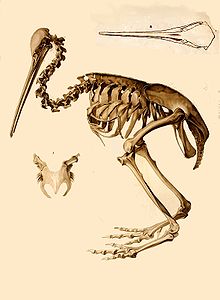Kiwi
![]()
This article is about the bird kiwi; for other meanings, see kiwi.
![]()
Apteryx is a redirect to this article. For the Bohemian bishop with this pseudonym, see Jan Blahoslav (1523-1571).
Kiwis (genus Apteryx) or snipe ostriches are flightless, nocturnal birds in the forests of New Zealand. The genus is the only one of the family Apterygidae and consists recently of only three or five species, depending on the doctrine. Among the ratites, kiwis are by far the smallest representatives.
The kiwi is the national symbol of New Zealand. From him derives the proper name of the inhabitants of New Zealand as "Kiwis". The population of kiwis is estimated in a study from the year 2021 at only 3000 individuals.

early drawing of a kiwi skeleton
Features
Kiwis are not only the smallest of all ratites, but their biology differs greatly from the other families of ratites. They are 35 to 65 centimeters long, up to 35 centimeters tall, and weigh one to five kilograms. Females are on average slightly larger and 10 to 20 percent heavier.
They wear brown plumage, which almost looks like hairiness. Like all ratites, kiwis lack the pectoral crest, where the flight muscles normally attach. Thus the kiwis still have small, four to five centimetre long wings, but they are not able to fly with them. The wings have small claws at the ends and remain hidden under the plumage. The claws have no discernible function and are apparently rudiments found equally in some emus and cassowaries.
Kiwis have no externally visible tail, which contributes to the fact that they have an unusual oval body shape. Contributing to this appearance are the legs, which are shifted far back. These powerful legs, like those of most birds, have four toes, which enable kiwis to run well and quickly. Longer flight distances, however, are usually unnecessary in their confusing habitat. The head of the kiwi is relatively small, the beak very long and curved downwards. The beak of the striped kiwi is over 20 centimetres long. It is a good 30 percent larger in females than in males. The upper beak is slightly longer than the lower beak. Kiwis often lean on their beaks to keep their balance when standing. Kiwis cannot see very well, but they can hear very well and - a special feature among birds - they can smell very well. The nostrils are located at the tip of the beak, not at the base as in most birds. At the base of the beak, kiwis have "bristles" that resemble the vibrissae (whiskers) of mammals, but are actually modified feathers.
A further characteristic is the body-temperature, that lies with 38 °C far under that of most birds (42 °C) and rather resembles that of a mammal.
Voice
Because of their nocturnal and hidden lifestyle, vocalizations are often the only thing people hear from kiwis. Kiwis call all year and all night, except during strong winds and on very bright full moon nights.
The calls are shrill whistles that carry up to five kilometers in favorable conditions. As kiwis emit them, they stretch their necks and beaks upwards. Males call more often than females, and their whistles sound different in pitch and pitch length.
The calls seem to play a role mainly in territorial defense. They are often answered by kiwis of neighbouring territories.
Questions and Answers
Q: What is a Kiwi?
A: A kiwi is a type of bird from New Zealand.
Q: What family do Kiwis belong to?
A: Kiwis belong to the family Apterygidae, and the genus Apteryx.
Q: Are there different types of Kiwis?
A: Yes, there are several species and sub-species of Kiwi.
Q: What is the Kiwi a symbol for?
A: The Kiwi is a symbol for New Zealand.
Q: Why are people from New Zealand nicknamed "Kiwis"?
A: People from New Zealand are nicknamed "Kiwis" after the bird because it is a national symbol.
Q: How does a Kiwi look?
A: The Kiwi has a long beak and brown feathers that look like fur. They cannot fly, and their wings are so small that they cannot usually be seen.
Q: What is unique about Kiwis' senses?
A: Kiwis cannot see well, but they can hear very well. They are also the smallest ratite birds.
Search within the encyclopedia